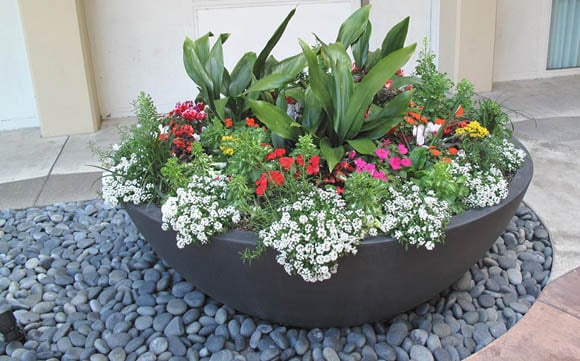There are two fundamental reasons TerraCast Products is known for making one of the most durable custom outdoor planters on the market: 1) Materials, and 2) Process.
Stone, concrete, metal—there are many different materials used to create planters. Most of these materials are prone to cracking, staining, or rusting in a matter of one to several years. There’s one material that rules supreme in terms of long-term durability, and that’s our unique Resin-blend.
Custom Outdoor Planters Made From LLDPE
We use a type of resin known as Linear Low Density Polyethylene (LLDPE). It’s a form of plastic that is lightweight, durable, and recyclable. Additionally, it offers a more eco-friendly and cost-effective alternative to other materials. Resin is pretty much a superhero—it doesn’t rust, corrode, or stain, and it’s not prone to cracks caused by freeze/thaw cycles.
What is a Freeze/Thaw Cycle?
Freeze and thaw cycles can impact everything from brick walls to stone planters—in fact, it can impact any solid porous material. Porous materials absorb water through the first layer, which means water can get trapped beneath the surface. When the temperature dips below 32 degrees F (the freeze point), moisture freezes into a solid—expanding and pushing on surrounding materials, say for instance the inner walls of a planter. When the weather heats back up again, the ice thaws back into a liquid, reducing its mass and subsequent pressure. This happens repeatedly each winter and over the course of years, and ultimately leads to the development of cracks and breaks.
How to prevent the freeze/thaw cycle from ruining your custom planters
You need a planter made from a non-porous material that does not readily absorb moisture. By keeping moisture out from the get-go, our planters proactively prevent freeze-thaw cycles from happening in the first place.
Not only are TerraCast’s resin-based planters non-porous and non-hydroscopic, but they can withstand temperatures ranging between -40 degrees and 140 degrees F.
The issue with dense non-porous materials
Many non-porous (and porous) materials used to create planters are dense—and dense things break easily upon impact. The great thing about our resin-based planters is that they are flexible enough to withstand a surprising impact load without breaking.
Other benefits of our non-porous and non-hydroscopic planters:
- More resistant to stains from dirt and debris and graffiti, just about anything can be cleaned off using at home cleaning products. In the most extreme cases, a pressure washer will remove the stain.
- Less prone to leaks
- Helps keep moisture and nutrients necessary for plants to thrive inside of the planter
- Boosted by the addition of UV-12 inhibitors to maintain longer lasting colors
Our Process Matters Too
Our roto-molding process is proven to offer procession from rims to corners, and all around. Planters start off as two mirror-image metal molds that are fit together with a hollow center. Before being turned into a powder, resin begins in pellet form of Linear Low Density Polyethylene.
Once in powder form, it gets its coloring in a blend machine. Pick from a range of solid colors, from white to black, or custom order any shade. During this process, we add UV inhibitors into the resin to maintain long lasting color for many years to come. We also offer six unique faux stone blends so you can enjoy the look of stone planters without the drawbacks. Want a planter that looks like granite? We know just how to mix and match the right colors.
Next, it’s time to pour the resin into a clamshell mold and bake it. The closed and locked mold is placed in one of our natural-gas powered ovens. It rotates 360-degrees the entire time it cooks to give it an even coat. The resin melts and solidifies into the shape of the mold.
When the mold is done, it is rinsed with reclaimed water for 15 minutes so that it cools at the right rate for long term durability.
It’s Not Just About High Quality Products, We Care About America Too
From reclaimed water to natural gas, we do whatever it takes to produce materials with as little impact to the planet as possible. We also care about supporting local Americans, which is why we produce our products right here in the USA using locally and sustainably sourced materials whenever possible. Depending on color choice, some colors, such as black, can be made using up to 100% post-consumer recycled material.

